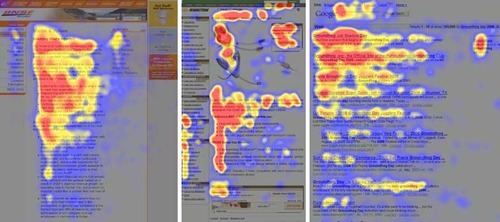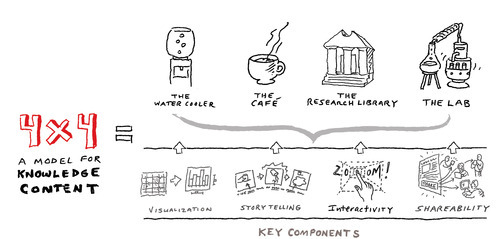No one reads any more. The long form is dead. The written word? That’s for grandpa! It’s all about video, baby! Everything I just said is entirely accurate. And yet it’s all wrong. The King is Dead. Long Live the King.

The fact is that the web and its associated information overload has given us all a form of ADD. Studies have shown that the majority of visitors will leave your site within 10 seconds. And the visitors who do come will skim your page, not read it. And you’ll be lucky if they read even 20% of a typical page. They scan your page in an “F” pattern, looking for something to care about before committing themselves to your content.
What to do about this? Especially if your content is knowledge content? If you’re selling ideas, not products, you don’t automatically have big glossy pictures of your coolest gadget you’re hawking, or a Swedish model in a bathing suit or a Justin Bieber music video.
The solution is what we call the 4X4 Model for Knowledge Content, and it consists of four key content types and four critical components of those content types. By following this format, your knowledge content (yes, even long form content) can engage your audience and get the right people to the right information (and get those who aren’t your audience to skip along – it’s OK if they leave your site within 10 seconds; remember, they’re not your audience!)

Models:
The Water Cooler
People gather around a water cooler to exchange quick snippets as brief respite from work. It’s short form. This content is succinct, direct and compelling. You can think of it as a headline, or a tweet or an ad. The only purpose is to engage the user, grab their attention and make them curious so they want more. Water Cooler moments can and should be found THROUGHOUT a web site – not just as headlines and ads, but also within the other layers of content.
The Café
People go to cafés for a coffee and a longer conversation. It’s an opportunity to delve into a subject at some length, but still isn’t deep study. You can think of it as longer form, produced content. This is a blog post or a one or two page article or a 3-minute video. This is a progression from the Water Cooler content to content that explains ideas and doesn’t just introduce them. In some ways Café content is the most difficult content to create because it needs to be crafted to tell a compelling story: a story that is easy to relate and to which visitors and the media can latch on. As mentioned above, Water Cooler content plays a critical role in this layer. An article needs a visual and/or callout text to bring attention to key points within the article. (This post you’re reading right now is an example of Café content.)
The Research Library
You go to the library to really learn about a topic. If you’ve heard an interesting stat (Water Cooler) and chatted with a colleague about it (Café) and it’s interesting to you, you will go to the library and dig deeper. You have self-selected as an interested reader on the topic. The Library contains the research and data that back up what is asserted at the Water Cooler and Café. It is your more scholarly, long form content.
Just remember, the Water Cooler moments shouldn’t disappear – a research report that is a wall of grey text will be accessible to, and read by, a far smaller audience compared to one that is broken into smaller pieces, includes images and data visualizations and key points as callouts. Also, the Café is a critical piece of the Library content. Every piece of Library content you publish should have an associated executive summary, abstract, or chapter introduction or some other Café content.
The Lab
The lab is where users can interact with the data found in the Research Library. This is the rarest form of content but, in many ways, it’s the most powerful. If you choose data and bubble it up to a headline, you’re making a thousand editorial decisions. Water Cooler moments are all agenda-driven. Café moments slightly less so, library moments even less. However, even in the research library, the data has been massaged and analyzed and delivered in a package. In the lab, you open the vaults and give users access to the data. They can twist the knobs and make it about them and their interests.
In addition to our four models of content, we have four critical components that should be used throughout the models. The arguments for them are many, but the key idea is that these elements all increase understanding, engagement, retention and social sharing. This will lead to better outcomes for your users and, therefore, for you.
Components:
Visualization
Consider a bar chart compared to a table of data in Excel. Which one is understandable within that all-important 10 seconds? Which tells a story? Visualization is not just about data, but also concept and geographic visualization.
Story-Telling
Explaining a concept is nothing like weaving a narrative. If you can tell a story, you are able to convert the abstract into something people can relate to. Liberal use of video is an effective story-telling and visualization tool and we recommend it highly, but it’s not the only way.
Interactivity
If I can see something, I can understand it. If I can touch it, I can know it. Why is the web a successful and popular medium? It’s not just that it’s convenient. It’s also that it allows us to be the masters of our own destiny. I don’t have to wait for the Boston Globe to land on my doorstep and read what they chose to write. I’m free to explore online and find my own content. This is a critical component to remember when delivering content. This does NOT mean over-using hyperlinks. It has been shown that understanding decreases when you add too many hyperlinks within content. But it does mean offering interactive experiences such as Lab moments and/or images that can be zoomed for more detail and/or communities to engage in.
Shareability
How easy is it to share a full research report and for the recipient to consume that report? Compare that to sharing/consuming one data point or one quote. The power of water cooler moments is strongest when you think about sharing. Those are the nuggets most likely to be shared by your audience – leading more traffic back to all levels of your site content. Oh, and you have to have the basic sharing tools so it’s easy (Tweet and Like buttons, for instance) – copy/paste/email is no longer a viable sharing model.
The 4X4 approach is the secret to presenting knowledge content in a way that engages your audience, stepping them into the right level of content based on their needs, and improving outcomes from that content. Try 4X4 and you won’t go back to a rear-wheel-drive approach ever again!
